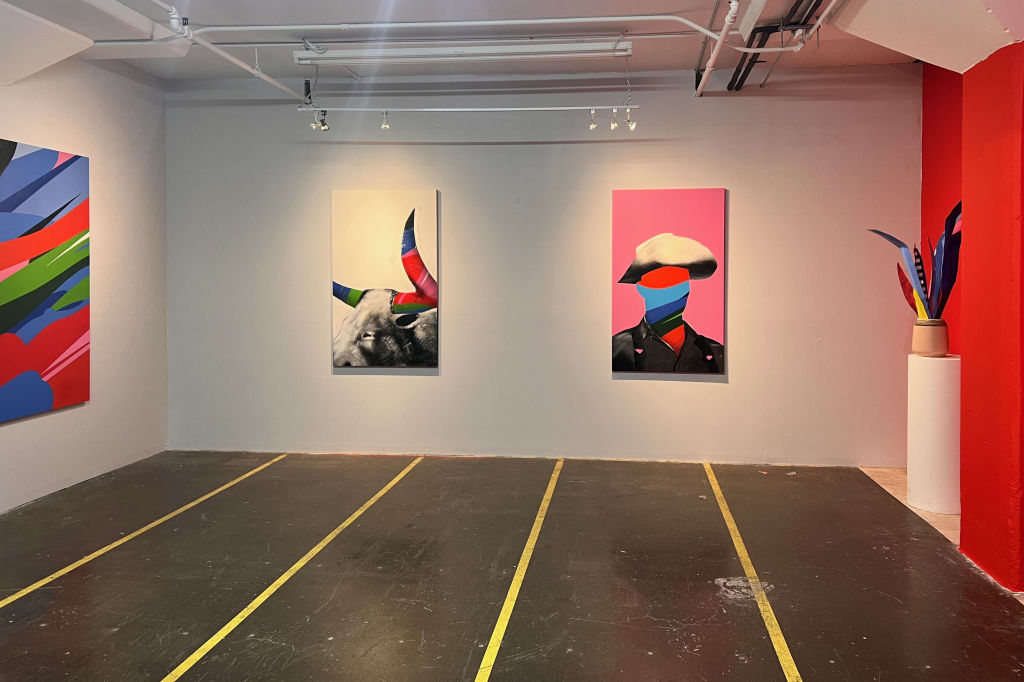Culture
 "Black Cowboy." Photo courtesy of artist.
"Black Cowboy." Photo courtesy of artist.
The Wild Wild Forgotten West: “Black Cowboy” Sheds Light on a Lost Fact
December 8, 2022 @ 10:00am
D.C.-based artist Brandon Hill is ever curious. Growing up with a schoolteacher for a mother, he often finds himself re-reading history books when not painting murals or organizing events around the District as one-half of No Kings Collective. Now re-examining familiar U.S. history as an adult, he is noticing blind spots from what he was originally taught.
“I spent a lot of time learning American history and African American history but did not come across the fact that 25% of cowboys were Black,” Hills says about learning the statistic only after extensive research. “I’ve found with history, not knowing major facts is common. But this one kind of blew my mind. Twenty-five percent of anything is a lot.”
Following the Emancipation Proclamation in 1863, being a cowboy was one of the few jobs available to Black people that offered autonomy and independence from service occupations, according to African American historian William Loren Katz. During the Civil War, while Texas ranchers fought in the war for the South, slaves were left to care for the ranch and cowherd. Ranchers’ reliance on slave labor and their developed skillset, later served freed Black cowboys in the post-war era who became vital in keeping ranches running.
Discovering this history spurred Hill to create his latest solo exhibit, “Black Cowboy.” Open through the end of the year at The Bishop Gallery in Brooklyn, New York, Hill created a mixed media show that re-examines the whitewashed cowboy imagery a la John Wayne and Clint Eastwood. Works like a 2D portrait of a cowboy with a missing face or a super-sized cigarette box sculpture with the logo “Kill’Em’s,” play not only into the forgotten history of Black cowboys but also the symbolism attached to the Western narrative, especially in film.
“There’s a 100 years of invented history of people not just copying Western knowledge, but copying Western films,” Hill says. “Normally Black people are not in them at all, or it’s a story arc where the Black man is riding into town and it’s bewilderment. If history is telling me 25% of cowboys were Black then the story arc in movies is make-believe.”
Hill wants the viewer to be able to immerse themselves in the exhibit and engage with soundbites of American mythmaking through the lens of modern day. For this show, he pushed himself to create a world in which the visitor feels like they are entering a movie set of a Western. Often with his solo exhibit work, Hill builds upon already existing art to continue the dialogue. In this instance, he is acutely aware of the effects of this lost fact.
“The ramifications are real,” Hill notes. “Like the backlash to Lil Nas X’s song ‘Old Town Road,’ because it’s appropriating country culture. But I’m like, ‘Well, 25% of country culture was Black.'”
On December 17, Hill will host his artist talk at The Bishop Gallery and hopes to invite some modern-day Black cowboys from ranches and rodeos. Above all, Hill hopes people will have a new image and perspective of the West.
“The West was really more of a multicultural place. This isn’t make-believe. This isn’t ‘Bridegerton.’ This isn’t reimagining. This really happened.” And in true Hill fashion, he quickly quips, “Also just to show some kickass art.”
“Black Cowboy” is showing through the end of the year at The Bishop Gallery, with Brandon Hill’s artist talk on December 17 at 6 p.m. To learn more about Hill and his work, visit nokingscollective.com or follow him on Instagram @nokingscollective and @chicken.of.insta.
The Bishop Gallery: 630 Flushing Ave. Brooklyn, NY; thebishopgallery.com // @thebishopgallery
Enjoy this piece? Consider becoming a member for access to our premium digital content. Support local journalism and start your membership today.







